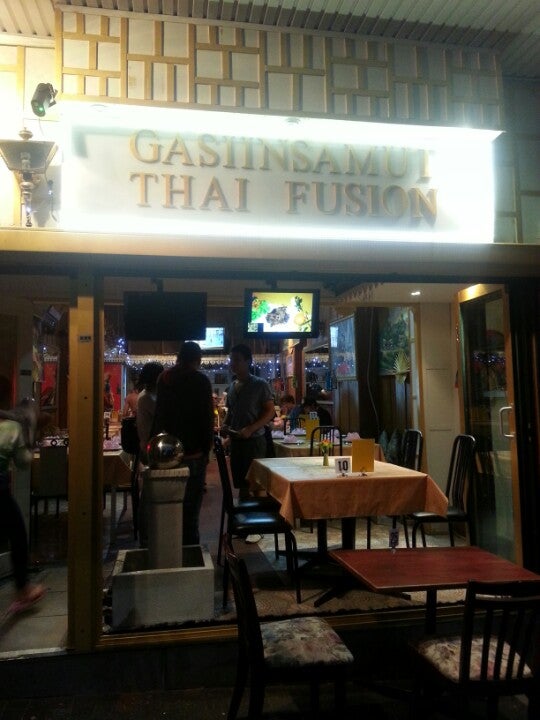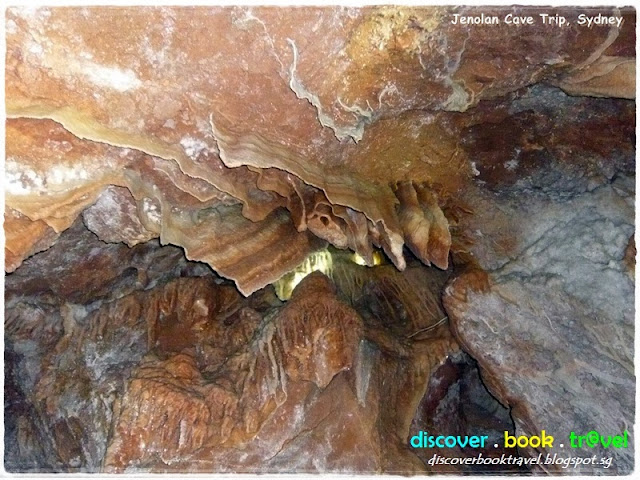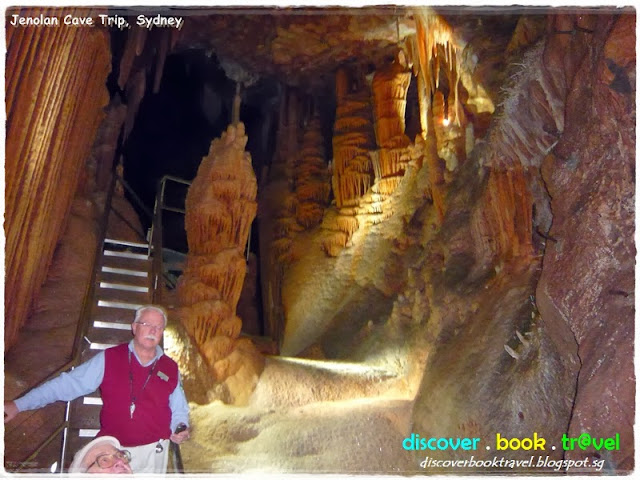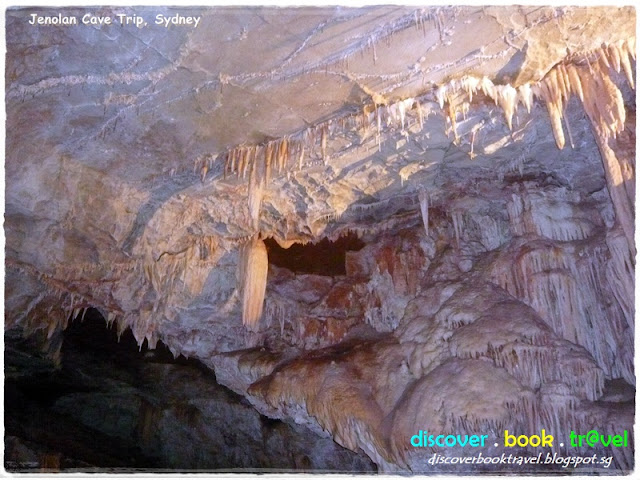Sydney . 2013 . May 20
This post is part of our Sydney 7 days 6 nights Trip Itinerary and Report. Do check out the full itinerary and our reviews here.Many of us are more familiar and acquainted with the
famous Three Sisters at Echo Point in the Blue Mountains Sydney. However, the lesser known
Jenolan Caves in the Blue Mountains is another place of interest that offers a whole new exciting experience.
The Journey to Jenolan Caves, Blue Mountains
Jenolan Caves is located around 74km away from
The Carrington Hotel Katoomba where we were staying. Tommy and I do not drive, so the next best option to get ourselves to the caves would be to p
urchase a day tour (there is no public transport to the Jenolan Caves). A few operators offer similar, if not identical tours to the Jenolan Caves, but do take note that these day tour operators do nothing but ferry you to and fro from Katoomba to Jenolan Caves with a bit of commentary thrown in to entertain you during the journey.
The actual cave tours is conducted by the staff of Jenolan Caves themselves, and whichever day tour you take, you will end up with the same cave guide that Jenolan assigns for that time schedule.
At 9:45am, all of us going for the Jenolan Caves tour gathered at the ticketing office of the Blue Mountains Trolley Tours. We had a huge bus for this tour, but only 4-5 of us tourists in the bus! So it was a fairly comfortable ride with lots of space.

The promised commentary never took place, but oh well, we can do without that and focus on the rolling scenery outside.
The journey from Katoomba to Jenolan Caves took about 1.5 hrs, and at some point, we gained elevation along the way.
Tip: Try to be seated at the left side of the bus and snap those pictures of the beautiful Blue Lake at the entrance of the Jenolan Caves, so named for the colour of its water.
Welcome to Jenolan Caves!
The Jenolan Caves are massive! Consisting of 11 spectacular caves, our first impression of the caves was an overwhelming sense of awe.
The Jenolan Caves are made up of limestone structures. About 430 million years ago, this very ground was part of a shallow warm ocean. Over millions of years, sediments comprising of dead marine animals such as corals and mollusc built up on the ocean floor and were compressed layer by layer, forming limestone rocks. Gradually, as the ocean recedes, the limestone structures were subjected to erosion, forming the caves that we see today.
Lucas Cave Guided Tour
Our tour package with the Blue Mountains Trolley Tours included admission to the Lucas Cave and Orient Cave. The Lucas Cave tour is the most popular tour at the Jenolan Caves, and tourists who are hard pressed for time are encouraged to do this tour first.
The Lucas Cave guided tour starts at 11:30am, barely minutes after we arrived. It was a pretty large group, not surprising, given that this is the most visited cave in Jenolan. We found only later that the
Lucas Cave is actually ranked as ‘strenuous’, and with 910 steps to climb, is one of the most taxing cave explorations in Jenolan.
Our tour guide started us off with a brief history of the Jenolan Caves, how it was formed and most importantly, the cave rules, not just to ensure the safety of visitors, but also to safeguard and protect the natural state of the caves!
After the mammoth task of climbing a long flight of stairs, our caving adventure officially begins. What appears as a small entryway into the Lucas Cave soon repeats inside everywhere else in the cave. For once I am glad I am short and petite, but even so, I find myself having to bend to avoid hitting my head on the rocks above. We filed into the cave in a single line, trying hard to adjust our eyes to the dimmer interior of the caves and at some points, the claustrophobic sense of being enclosed within a narrow rock structure.
The temperature within the caves is a constant 15 degree Celsius all year round, regardless of the weather outside. It promises to be a nice, cooling hike in the caves, but for people coming from the sunny side of the globe, it practically is a chilly experience.
Our tour guide leads the way in front, using a remote to control the lightings as we enter each chamber of the cave. Some parts of the cave are also illuminated with coloured lights.
‘The Cathedral’
The Lucas Cave has the most massive chambers amongst all the caves in Jenolan, and the most spectacular one is ‘The Cathedral’ which is 54 metres high, and has one of the best acoustics in the world. For that reason, it is often used as a venue for musical performances and weddings (very apt, since this chamber is called ‘The Cathedral’).
Have you ever wondered how it would be to explore a cave on your own, without facilities in there to help you along? Our guide demonstrated that by switching off all the lights in ‘The Cathedral’! It is pitch black and we could not even see our hands in front of us! It’s difficult to imagine how early explorers built the structures in the cave with only a headlamp to help them.
See the water droplets in the photo? The moisture level in the cave is high, and the steps tend to be wet and slippery, so it’s hardly an easy tour for young kids.
This area is called ‘The Slide’, with legends of visitors placed upon sacks and sent sliding down by the light of a candle. At the bottom of the slide lies the exhibition chamber where the famous ‘Broken Column’ is housed. Fortunately, thanks to early explorers who built staircases (albeit narrow ones), we need not be subjected to the slide.
As we descent deeper into the dungeon-like Lucas Cave, our guide stops periodically to gather us and point out natural formations and features of the cave.
These are the kind of structures we find regularly throughout the cave. They look like dried bacon hanging from the ceiling, don’t they?
Notice how the walls, ceiling and rocks sparkles?
Those are actually crystals embedded in the limestone formation. They are found all over the cave, but visitors are not encouraged to touch them (cave rules applies). Once upon a time, raiders actually carry off huge structures from the caves to extract crystals from them, resulting in a drastic depletion of natural resources in the cave. It was not until the Jenolan caves were listed as a preserved area in the 1860s that this practice was stopped.
‘The Broken Column’
‘The Broken Column’ is the most photographed structure at the Jenolan Caves. Located at the
Exhibition Chamber of the Lucas Cave, the Broken Column would have at one time been connected from roof to ground, but the gradual caving in of the rockpile on the ground caused it to break into half.
Our guide stopped at the Exhibition chamber with a powerful light pointer to point out interesting structures to us. Most of them are stalactites and stalagmite structures that have eroded to resemble animals, humans or deities, depending on how active your imagination is.

Doesn’t this look like a deity resting on the mountain top? It’s named as
‘The Bishop’, probably to tie in with the famous Cathedral.
The Underground River
Remember the Blue Lake at the entrance to the Jenolan Caves? The Blue Lake gets its source from the underground river of the Lucas Cave. The high calcium content (from dissolved limestone) gives the river (and hence the Blue Lake) the rich blue-ish green hue.
Looking down 20 metres from the bridge at the underground river. The cave is too dark for the camera to capture the looks of the river.
The Bone Chamber
The Bone Chamber was once littered with the fossils and bones of animals, but early explorers took them away with them. The bone that we see now is actually a deliberate effort to plant an ‘exhibit’ here. The highlights of this chamber is the myriad lights that decorates the cave. From this point onwards, it is a short walk to the exit of the Lucas Cave and to the Blue Lake where the underground river flows into.
Exit from Lucas Cave
After 1.5 hrs of climbing, descending and walking in narrow spaces, we finally were going to see daylight again!
The entire tour was so amazing and fascinating, we weren’t aware that 1.5 hrs had gone by.And who should greet us at our exit is a Wallaby! To be honest, I think we were both startled by the suddenness of each other’s approach. We both left hastily, me out into the open air, and him into the darker crevices of the cave. But not before we snapped a picture of him!
Looking at other another cave entrance and the Blue Lake from our advantage point somewhere in the middle of the mountains.
It was after the Lucas Cave tour that we found this notice board listing all the cave tours. We were surprised to find that the Lucas Cave was listed as ‘Strenuous’ and had the second highest number of steps to conquer. Frankly, though the upwards climb was tough, there were multiple stops and rests along the way to look at structures so it didn’t feel as strenuous as it would be!
The Lucas Cave Tour takes place twice a day (at 11:30am and 2:00pm) on weekdays and more regularly on weekends. For the tour schedule and updates, visit the
Jenolan Cave official website.
The Blue Mountain Trolley Tours to the Jenolan Caves of the Blue Mountains operates from Katoomba at 9:45am daily and the tour will end at Katoomba at 5pm. For more information on the tours available, visit
http://www.trolleytours.com.au/jenolan-caves-tours.
Note: Do take note that it will not be necessary to purchase a day tour from the tour operators if you drive. The Visitor’s Centre at Jenolan Caves sells the individual cave tours and you could save a sum of money by purchasing the tickets directly from them (it is advisable to book early). As at the point of writing, entrance fees for the Lucas Cave and Orient Cave are AUD32 and AUD38 respectively (total of AUD70). Our Blue Mountain Trolley Tours costs AUD109 (meaning each pays AUD39 more for the transport back and fro between Katoomba and Jenolan Caves). There is no public transport to Jenolan Caves.
Coming up next –
Part II of the Jenolan Caves. Join us as
we go caving in the Orient Cave.
This post is part of our Sydney 7 days 6 nights Trip Itinerary and Report. Do check out the full itinerary and our reviews here.

 RSS Feed
RSS Feed






















































































